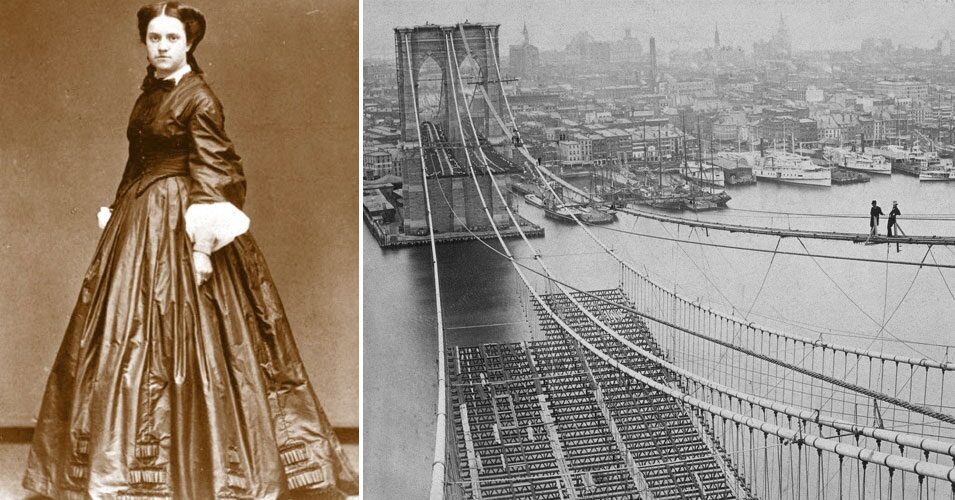As part of our celebration of Women’s History Month, we want to highlight extraordinary Women in Construction, past and present. Our first profile is Emily Warren Roebling, who was instrumental in building the iconic Brooklyn Bridge. Also be sure to check out the latest episode in our Women in Construction podcast series to listen to CEO Steve Harper’s conversation with Molly Ironmonger, System Director for Planning and Preconstruction for Bon Secours Mercy Health. Molly is an engineer by education, a construction manager by trade, and a leader by passion. You won’t want to miss her perspective and insights!
Completed in 1883, the Brooklyn Bridge was dubbed the “eighth wonder of the world.” It was the longest suspension bridge in existence and the first to be built with steel. Its construction took 14 years and was marked by vicious political infighting, contractor corruption, and construction challenges — including the deaths of more than two dozen workers. And if not of the efforts of one remarkable woman, it may never have been finished at all.
Washington Roebling had been the project’s chief engineer for about a year when he became seriously ill — likely decompression sickness caused by breathing compressed air while working in wooden caissons submerged beneath the river. Partially paralyzed and bedridden, it seemed a certainty that he would have to be replaced.
But his wife Emily refused to allow that to happen. Though not yet 30 years old and largely self-educated in math, science, and engineering, she stepped into the void of her husband’s absence to manage the day-to-day details. She visited the site often to monitor progress, taking detailed notes and sharing them with Washington. She then relayed his orders back to the crews.
“I have more brains, common sense, and know-how”
As Emily Roebling’s knowledge and experience grew, she became more comfortable taking the lead on decisions. She gave detailed instructions to manufacturers using drawings and her highly developed mathematical skill. She worked directly with bridge officials and field engineers to solve technical challenges. She negotiated supplies and approved contracts. She even acted as liaison to the board of trustees and the mayors of Brooklyn and New York, superbly managing competing factions.
Years later, Emily wrote in a letter to her son: “I have more brains, common sense, and know-how generally than have any two engineers, civil or uncivil, and but for me the Brooklyn Bridge would never have had the name Roebling in any way connected with it!”
Erica Wagner, author of Chief Engineer: Washington Roebling, the Man Who Built the Brooklyn Bridge, goes even further: “I don’t think that the Brooklyn Bridge would be standing were it not for her. She was absolutely integral to its construction.”
When the Brooklyn Bridge opened on May 24, 1883, Emily Roebling was given the honor of being the first person to walk across the completed structure. Today, a plaque on the bridge commemorates both Washington and Emily Roebling for their accomplishment.
Project management, Brooklyn-style
Emily Roebling’s achievements are remarkable, especially given her era’s emphasis on women’s traditional roles. As she became a more vocal and visible member of the greatest architectural project of the century, she risked becoming the target of rumors and newspaper gossip. But that didn’t prevent her from doing her job effectively . . . in part because she exemplified 4 critical project management behaviors that remain best practice even a century and a half later.
1. Ensure all stakeholders understand the requirements. Emily had an eye for detail that proved invaluable. Working initially from her husband’s instructions and later from her own knowledge, she gave specific instructions to workers, engineers, and vendors. Because her status might be questioned given the mores of the time, she relied on written directions that could plausibly have been dictated or approved by Washington. The unintended benefit of having those records was to ensure that requirements for materials ordered or scope of work performed were unambiguous. Several times she was able to use that documentation to force greedy vendors to honor the original terms of a deal, or to make unscrupulous contractors redo subpar work at their own expense.
2. Monitor and track progress regularly. As soon as Washington became ill, Emily began daily treks to and from the bridge. She took copious notes on what he said remained to be done, and compared to those to what she saw actually happening on the site. By then sharing those observations with him, the Roeblings ended up with a surprisingly effective quality control process — likely more detailed than if Washington were simply informally watching progress on his own. And the documentation gave them a paper trail to better hold contractors and vendors accountable.
3. Communicate clearly and effectively. Emily was an avid note and letter writer. Whether providing feedback about a proposed contract or responding to a mayoral concern, she proved able to communicate clearly, concisely, and purposefully. Given the nature of the arrangement, it would have been easy for her to simply convey her husband’s instructions. But she made communication a two-way street: during her daily site visits, she made time to answer workers’ questions and provide clarifications (subsequently documented in writing, of course!).
4. Develop both leadership and technical competencies. Although mostly self-educated when it came to higher math and engineering, Emily showed a natural aptitude for the content. But she knew she needed more. After Washington became bedridden, she began more intensive personal studies about technical issues surrounding the bridge’s construction. She learned about strength of different materials, stress analysis, cable construction, and calculation of catenary curves. Although she couldn’t entirely close the gap, she could ensure that she was able to ask the right questions and protect herself from being manipulated.
Takeaways for today
For modern construction project owners who lack deep AEC technical expertise, Emily Roebling’s example is doubling inspiring. Not only was she a women who defied the limitations of her society, she was a talented amateur who through will and process managed a project that cost more than $320 million in today’s dollars. She successfully navigated incompetence, corruption, and competing agendas.
Fortunately, today’s owners have tools at their disposal to make construction oversight considerably easier than Emily’s experience. Owner-focused construction project management software like Owner Insite’s cloud-based platform helps automate many of the tasks that Emily used to keep her workers on-schedule and on-budget. Owners can maintain visibility over every aspect of the project, from daily site activities to real-time accounting. And all your documents, from contracts to emails to inspection reports, are preserved and archived at closeout.
To explore how Owner Insite might help you minimize your risk and maximize your ROI, contact us to schedule a demo.




